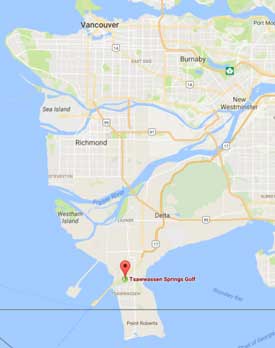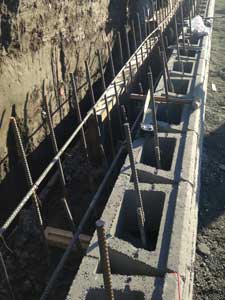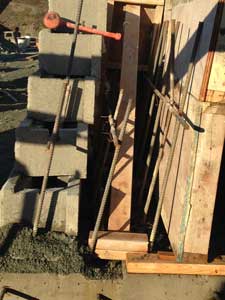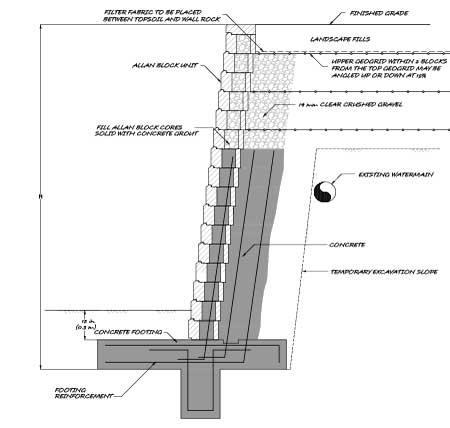Project Information
Name: Tsawwassen Springs Golf Course Expansion
Tsawwassen, BC
Product: AB Classic
Size: 2,000 ft2 (610 m2)
Wall Builder:
Canadian Landscape and Civil Services
Allan Block Manufacturer:
Expocrete - Richmond, BC

An Allan Block Masonry Application Wall Excels In A Complicated Space
Tsawwassen, British Columbia is mostly a suburban area considered to be the most southern community of the great Vancouver area. The city borders the US on the very unique peninsula called Point Roberts which juts out into the Strait of Georgia. Tsawwassen is home to only 21000 residents but sees a lot more traffic from visitors through the Tsawwassen Ferry landing, the Roberts Bank superport and two heavily used golf courses.
Tsawwassen Springs Golf Course expanded their facilities in 2015 which of course included additional parking facilitated by using Allan Block retaining walls to create usable flat land for the expanded lot. For that project, the Course owners worked with Expocrete, who produce all the Allan Block products in Western Canada, and LANDTEC Consultants LTD to design the Allan Block walls. Now, only two years after that first expansion came the need for even more facilities and more parking. However this expansion was going to be more difficult due to site constraints avoided in 2015. The only area available for more parking was home to a 10 in. (250 mm) diameter high pressure water main that simply could not be moved and had to be assessable for any future maintenance. The site designers reviewed all options and decided that a cast in place cantilever retaining wall using a toe-forward footing design would be the only way to get the back of the wall close enough to the parallel pipe to allow room for parking.
The golf course owners were not satisfied with that decision because they wanted any new walls to match the Allan Block walls constructed in the previous expansion. The site designer reached out to LANDTEC to review their old Allan Block designs from two years ago and see if AB could be used again to solve this site problem. LANDTEC is very experienced with Allan Block designs and is familiar with the block’s flexibility and strength and they had the solution. LANDTEC proposed they do a highbred wall using Allan Block in a masonry application for the lower two-thirds and finish the top off with a traditional geogrid layer application. This design would work exactly like a cast in place concrete wall but hold onto the high level of aesthetics that Allan Block products provide.
LANDTEC Consulting knew that the hollow core and the high compressive strength of the AB Classic units could be used as a masonry application. This is where the stem of the wall is building off of a cantilevered concrete footing just like a cast-in-place wall. LANDTEC worked closely with the design engineers at Lang Structural Engineering Inc. to do the cantilever design. They determined the overturning force to be resisted at the tallest 10.5 ft (3.2 m) section and sized the vertical steel appropriately. They modeled the steel dowels to be roughly centered in the AB Classic cores, 18 in. (460 mm) on center, to facilitate easy block placement. For additional overturning and shear strength in the stem, in case there was ever a problem with the pipe, the design team designed a cast-in-place concrete stem to be cast at the same time as the Allan Block courses. This additional pour would be formed by the back of the Allan Block units and by removable plywood forming. The design team, using typical cantilever design theory determined the size of the footing, both forward length of toe and the required slab thickness. For an added level of shear resistance a shear key would be constructed in the bottom of the footing.

To finish out the top 4 ft (1.2 m) a traditional geogrid application was designed. The idea here was ease of construction, easy access to the pipe and the ability to build in the overturning resistance from the post and rail fence being added to the top of the wall into the geogrid layers. The geogrid application solved many things for the current and future life of the structure.
The site designers, LANDTEC and the owners wanted no worries during construction so during the bidding they required that an Allan Block Certified installer be a requirement to win the project. Allan Block Master Wall Builder Darryl Grassick and his crew from Canadian Landscape and Civil Services (CLCS) sucessfully won the bid and met the certified training requirments. They not only have the equipment but also the knowledge and experience to make a complicated project run smoothly from start to finish.

Construction began by clearing the site and extremely careful excavation in the area closest to the pipe location. The utility company had done the proper site evaluation and marking but CLCS took great care to personally locate the water main during excavation. The early construction was slowed down due to wet weather but eventually the shear key, footing and footing dowel bars were all cast and ready to accept the Allan Block stem. To ensure the Allan Block courses were level, they placed the first course in a mortar bed on top of the footing and once cured they were off to the races stacking block. They cast no more than four courses in one pour to ensure the wall stability and used plywood formwork for the additional cast-in-place stem due to the wet site soils. Between concrete pours CLCS made sure to end the pour within the block so the cold join was in the perfect location for the next day’s pour and made a point to ensure that all excess or spilled concrete was cleaned from the top of the block and the face of the units so the next day’s block placing would not have any problems and the faces had no staining which would be very difficult to remove at the end of the project.


The Allan Block masonry application construction continued until the two-thirds height was reached. Once the wall was cured the soil backfilling was completed and the top geogrid wall was assembled. Final step for CLCS was to coordinate the fence post locations with the fence installer and place the construction tubes in their proper location.
Once the caps were installed the landscape crew moved in to final grade the top of wall, install the fence and install sod and landscaping. Shortly thereafter the parking lot was installed the new area was open for business.
A well planned, designed and coordinated project allowed a highly qualified installer finish a complicated project in just 2 weeks and within budget.
For more information on see our alternative wall reinforcing options or contact the Allan Block Engineering Department.

